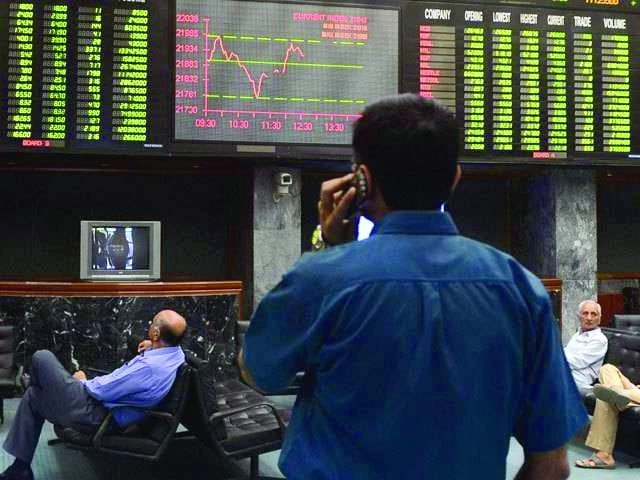Business
Stocks jump on positive domestic and regional cues | The Express Tribune

KSE-100 index gains 2,473 points amid political stability, security success, and calmer regional outlook
The Pakistan Stock Exchange (PSX) extended its winning streak on Thursday, with the benchmark KSE-100 Index surging 2,473.55 points, or 1.56%, to close at 160,657.50. Trading remained robust throughout the session, as the index touched an intra-day high of 160,944.51 and a low of 158,971.49. The upbeat sentiment reflected renewed investor confidence driven by political progress, improved security conditions, and a calmer regional outlook.
The rally was broad-based, with major sectors such as cement, fertiliser, and oil & gas leading the charge. Investor confidence improved sharply as signs of political calm and regional stability supported a broad market rebound. Participants viewed recent political progress as a move toward steadier governance, helping restore faith in the continuity of economic reforms. The more predictable environment encouraged renewed interest across major sectors, with sentiment turning decisively positive through the trading session.
Momentum was also lifted by a string of encouraging domestic and regional updates. The Sri Lankan cricket team’s decision to continue its Pakistan tour after fresh security assurances was taken as a strong signal of growing international confidence in the country’s stability. At the same time, a successful clearance operation against terrorist elements in Khyber Pakhtunkhwa reassured investors about the security landscape. On the diplomatic front, the Indian Cabinet’s measured reaction to the Delhi explosion, which avoided any direct reference to Pakistan, eased cross-border concerns. Collectively, these developments fostered a sense of calm and optimism, driving robust buying interest across the board.
KTrade Securities Equity Trader Ahmed Sheraz wrote that the PSX witnessed a strong reversal of fortunes on Thursday as the KSE-100 Index surged by 2,473 points (+1.56% DoD) to close at 160,657 points. The rally was broad-based with major sectors, including cement, fertiliser, and oil & gas, all recording significant gains.
Read: PSX suffers 3,668 point plunge, as 27th Amendment, terror reports trigger sell-off
Market sentiment improved on the back of multiple positive developments. The passage of the 27th Constitutional Amendment in Parliament was viewed as a step towards political stability. Confidence was further strengthened after the Sri Lankan cricket team decided to continue its tour in Pakistan following renewed security assurances. Additionally, a successful clearance operation in Khyber Pakhtunkhwa and the Indian Cabinet’s statement on the Delhi explosion, notably not mentioning Pakistan—helped ease concerns, collectively supporting the market’s momentum.
The rally was driven by strong performances in blue-chip stocks such as Fauji Fertiliser, Lucky Cement, Maple Leaf Cement, DG Khan Cement, Mari Energies, Fauji Cement, Cherat Cement, Hub Power, and Pioneer Cement, which together contributed significantly to the day’s surge. Additionally, MLCF and PIOC hit their upper circuits (10%) following MLCF’s announcement to acquire a controlling stake in PIOC.
Despite the index’s strong upward move, overall market participation remained relatively muted. Looking ahead, Sheraz expects sentiment to remain closely tied to developments on the law-and-order situation, political landscape, and macroeconomic front, particularly the release of the upcoming IMF tranche and evolving regional geopolitical dynamics.
Overall trading volume jumped to 797.1 million shares versus Wednesday’s tally of 757.2 million, while the value of traded equity stood at Rs35.1 billion. Shares of 477 companies were traded, of which 285 closed higher, 142 fell, and 50 remained unchanged. Bank Makramah emerged as the volume leader with 112.2 million shares, rising Rs0.02 to close at Rs5.59.
Business
Sotheby’s CEO sees ‘very strong demand’ ahead of $1.4 billion art auctions

The fall auction sales in New York next week are expected to top $1.4 billion, marking a 50% increase from last year and a potential rebound for the art market after three years of declines, according to art experts.
A star-studded lineup of famous trophy works — from a $150 million Gustav Klimt portrait to a multimillion-dollar gold toilet — will lead the auctions at Sotheby’s, Christie’s and Phillips next week. Often the most important week of the year for the art market, the sales follow stronger-than-expected results for recent sales in Paris and London and could restore confidence in the art market.
Dealers and auction executives said the improvement is being driven by stronger demand as well as better supply. Falling interest rates, soaring stock prices and trillions of dollars in wealth creation in both public and private markets in recent months are fueling greater confidence by wealthy buyers.
At the same time, a parade of ultra-rare masterpieces are starting to come cross the auction block as sellers become more confident in prices and bidding.
“All year long we’ve seen very strong demand in the art market,” said Charles Stewart, Sotheby’s CEO. “Our demand levels have been setting records, whether that’s bidders per lot or our hammer [prices] versus our low estimate or our sell-through rates. What we’ve seen more recently, though, is the supply catching up with the demand. Something’s definitely shifted in the last two months.”
The big headliners for the week come from the estates of Leonard Lauder — the billionaire heir to the Estée Lauder Companies — and Jay and Cindy Pritzker, of the Pritzker real estate dynasty. Sotheby’s is selling 55 works from the Lauder collection for a total of over $400 million. The works include Klimt’s colorful “Portrait of Elisabeth Lederer,” estimated at over $150 million, as well as two Klimt landscapes, one estimated at over $70 million and the other over $80 million. It also features six bronze Matisse sculptures and one of Edvard Munch’s famous “Midsummer Night” paintings.
This David Hockney work at Christie’s, “Christopher Isherwood and Don Bachardy,″ is estimated to go for $40 million to $60 million.
Crystal Lau | CNBC
The Pritzker collection includes 37 works estimated at over $120 million, including a Van Gogh still life estimated at more than $40 million.
Christie‘s has several sought-after works estimated at between $40 million and $60 million, including Monet’s “Nymphéas” water lily painting, David Hockney’s “Christopher Isherwood and Don Bachardy.” It’s also offering Mark Rothko’s “No. 31 (Yellow Stripe)” for more than $50 million.
“I think next week will be a giant sigh of relief that we’ve gotten over the worst,” said Andrew Fabricant, the veteran art advisor. “The mood is better, and given the quality of what they’ve got, I think they’ll do well. You don’t need 20 years of art history to understand the appeal of those Klimt paintings.”
Sotheby’s will benefit in part from the opening last week of its new global headquarters at the famous Breuer Building in Manhattan. The building — considered a masterpiece of brutalist architecture, strategically located on the Madison Avenue luxury shopping corridor — is already packed with crowds, with more than 10,000 visiting the exhibit as of Wednesday. The buzz and visibility is core to Sotheby’s strategy of attracting new collectors and educating the next generation of bidders about about art and culture.
“This is a tremendously important moment for us,” Stewart said of the building’s opening. “I think a number of our consigners [sellers] were also excited by the opportunity.”
Still, after three years of declines in auction sales, some dealers and art experts wonder whether next week’s rebound will have staying power. As older collectors fade from the auction scene, the next generation of buyers and collectors is showing different priorities and tastes.
While older collectors often sought status trophies and “wall power” by well-recognized artists, younger collectors are leaning toward emerging artists and lower-priced works. The generational divide has led to two different art markets — a multimillion-dollar high-end that’s been declining and a vibrant lower-priced market that’s attracting younger collectors.
Sales for works priced over $10 million fell 44% in the first half of the year compared to 2024, and plunged 72% from the post-pandemic peak of 2022, according to the Bank of America Private Bank “Art Market Update.” No works sold at auction for more than $50 million in the first half of this year, compared with 13 sales at that price point in the same period in 2022.
In 2024, dealers with sales of less than $250,000 reported a 17% increase in sales, compared with a 9% decline for those in the $10 million-plus segment.
“The more mature collectors are aging out and the next cohort may come with different motivations or tastes,” said Drew Watson, head of art services at Bank of America. “Many of that older generation of collectors over the past 30 years — the hedge fund principals, the private equity investors — are getting to the point where they are not as focused on accumulation and more focused on succession and transition.”
Watson said the declines in auction market totals, due largely to weakness at the very high end, has obscured an increasingly thriving gallery and art fair scene filled with younger collectors buying and learning about new artists. Younger collectors are also more interested in forging direct connections with artists rather than buying in the secondary market or auctions.
“Collecting as a lifestyle seems to be on the rise,” he said. “The art fairs are packed.”
Sotheby’s will be auctioning off Maurizio Cattelan’s solid gold toilet, called “America” as part of its fall auction.
Crystal Lau | CNBC
The sales next week will also feature a work that’s already sparked global debate over wealth and art. Sotheby’s will be auctioning off “America,” a solid gold toilet made by the Italian artist Maurizio Cattelan, who also created the infamous duct-taped banana (titled “Comedian”) that sold at Sotheby’s for $6.2 million.
“America” is one of two toilets that Cattelan made from 100 kilograms (about 220 pounds) of solid 18-karat gold. One version went on exhibit at the Guggenheim Museum in New York in 2016, where it was installed in a bathroom and attracted long lines of visitors.
It later went on display at the Blenheim Palace in England, where it was stolen and assumed to have been melted down for the gold.
The second one, which is the work being sold, went to a private collector. The New York Times reported that Steve Cohen, the hedge fund billionaire and New York Mets owner, is the seller.
While Sotheby’s hasn’t given a sales estimate for “America,” the gold itself would be worth about $13 million with today’s prices, which have soared over the past year.
Stewart said “America,” like “Comedian,” is a true cultural phenomena.
“What I loved about the banana last year was how it stirred discussion,” he said. “Everywhere I went around the world, people had a point of view on it, whatever it might be, and it prompted so much animated debate. I think ‘America’ will be much the same, because there’s so many different threads of the work that are fascinating — whether it is the object itself, whether it is the title, whether it is the gold, whether it is the art-historical references. When you put it all together, it’s just something that’s tremendously exciting.”
Many dealers and art experts take a different view, saying “America” is pure spectacle rather than art, and says little about serious collectors or artists.
“It’s a headline grabber that has nothing to do with art whatsoever,” Fabricant said.
Business
‘Failings at every level’ led to botched insulation scheme

A botched net zero scheme which has caused damp issues in thousands of homes was the result of ”serious failings at every level”, a UK government official has said.
Last month, the National Audit Office found that 98% of the 23,000 homes that had external wall insulation installed under two separate schemes will result in damp and mould if left unaddressed.
Its damning report also found that hundreds of homeowners’ health and safety had been put at immediate risk because the insulation work had not been done correctly.
Appearing before Parliament, Jeremy Pocklington, the most senior civil servant at the Department for Energy Security and Net Zero, said the failures were “unacceptable”.
These schemes commonly used external wall insulation, which involved fixing insulation boards to the exterior brickwork and then applying render to make it waterproof. It can go wrong when water becomes trapped behind the boards.
The damage also applies to about a third of homes which had internal insulation installed under the ECO4 scheme and the Great British Insulation Scheme, available to residents in England, Scotland and Wales.
More than three million homes have been insulated under a variety of government schemes over the last 20 years. Billions of pounds of public money have been spent on it.
Appearing before the Public Accounts Committee, Mr Pocklington began his evidence session by saying his thoughts were with the families and households affected.
The chair of the Public Accounts Committee, Sir Geoffrey Clifton-Brown MP, said the NAO report findings were the ”worst” he’d seen in 12 years of chairing the committee and accused the department of negligence.
Mr Pocklington said there had been poor oversight of the ECO4 and the Great British Insulation Scheme by Trustmark, the body responsible for overseeing the quality of the insulation work.
However, he added that the department ”did not oversee these schemes in the way that they should have done”.
Independent MP Rupert Lowe said this amounted to ”systemic failure of a government department”.
Acknowledging this remark, Mr Pocklington, said ”there are serious failings at every level of the system that are systemic”, and that the department “didn’t take enough steps to ensure that Trustmark was set up to deliver appropriately”.
Simon Ayers, the chief executive of Trustmark, earlier told the panel of MPs that his organisation had raised the issue of faulty installations with the Department for Energy Security and Net Zero from late-2022, but they were “informal operational meetings” and minutes were not taken.
Mr Pocklington explained that the department had been under pressure after dealing with the Covid pandemic and the effect on energy prices of the war in Ukraine.
Labour MP Clive Betts asked Mr Pocklington whether the department would take responsibility for all of the homeowners that have been ”badly treated” under all of the government’s energy efficiency schemes, not just those carried out since 2022.
Mr Pocklington said the focus was on the two schemes which had taken place since 2022.
Asked by Mr Betts if the government would “stand behind” affected homeowners, Mr Pocklington said the government’s responsibility was ”to ensure that the schemes we put in place operate effectively and that there are appropriate systems of consumer protection in place”.
Business
New foreclosures jump 20% in October, a sign of more distress in the housing market

fstop123 | E+ | Getty Images
Foreclosure filings climbed again in October, after sitting at historic lows in recent years, according to new data released Thursday.
While the numbers are still small, the persistent rise in foreclosures may be a sign of cracks in the housing market.
There were 36,766 U.S. properties with some type of foreclosure filing in October — such as default notices, scheduled auctions or bank repossessions, according to Attom, a property data and analytics firm. That was 3% higher than September and a 19% jump from October 2024, and marked the eighth straight month of annual increases, Attom said.
Foreclosure starts, which are the initial phase of the process, rose 6% for the month and were 20% higher than the year before. Competed foreclosures, the final phase, jumped 32% year over year.
“Even with these increases, activity remains well below historic highs. The current trend appears to reflect a gradual normalization in foreclosure volumes as market conditions adjust and some homeowners continue to navigate higher housing and borrowing costs,” said Attom CEO Rob Barber in a release.
Florida, South Carolina and Illinois led the nation in state foreclosure filings. On a metropolitan area level, Florida’s Tampa, Jacksonville and Orlando had the most filings, with Riverside, California, and Cleveland rounding out the top five.
Looking specifically at completed foreclosures, Texas, California and Florida had the most, suggesting those states will see more inventory coming on the market at distressed prices. There is still very strong demand for homes, especially in lower price ranges, so it is likely those foreclosed properties will find buyers quickly.
At the peak of the Great Recession, more than 4% of mortgages were in foreclosure, according to Rick Sharga, CEO of CJ Patrick Co., a real estate market intelligence firm. Today, less than 0.5% are in foreclosure, well below the historic average of between 1% and 1.5%. In addition, 4% of mortgages are delinquent; at the peak of the financial crisis, almost 12% were.
“So, no foreclosure tsunami to worry about,” said Sharga. “That said, there are a few areas of concern. [Federal Housing Administration] delinquencies are over 11%, and account for 52% of all seriously delinquent loans; we’re likely to see more FHA loans in foreclosure in 2026.”
He also noted that states where home prices have been falling while insurance premiums have been soaring — Florida and Texas, in particular — are seeing an uptick in defaults.
While home prices nationally are easing, they remain stubbornly high. Meanwhile, mortgage rates, which were expected to fall more sharply after the Federal Reserve started to cut rates, are still within a percentage point of their recent highs. Some recent buyers who thought they might have been able to refinance to lower rates by now may be feeling pressure, especially with still stubborn inflation.
Consumer debt is at an all-time high, delinquencies are rising in other types of consumer credit and the job market appears to be weakening — all of which could contribute to cracks in the housing market.
“None of these issues have impacted mortgage performance – yet, but it would be unrealistic to assume that these trends, along with slow home sales and declining home price appreciation, won’t lead to at least a slight increase in delinquencies and defaults in the months ahead,” added Sharga.
-

 Business1 week ago
Business1 week agoGST rationalisation impact: Higher RBI dividend expected to offset revenue shortfall; CareEdge flags tax pressure – The Times of India
-

 Tech1 week ago
Tech1 week agoBlood Tests for Alzheimer’s Are Here
-

 Sports1 week ago
Sports1 week agoPeat wows in debut as Arizona beats No. 3 Florida
-

 Business1 week ago
Business1 week agoSetback for expatriates? Delhi HC upholds mandatory EPFO membership; what this means for foreign staff – The Times of India
-

 Entertainment6 days ago
Entertainment6 days agoChina unveils£5.4 bn Fujian, its most advanced aircraft carrier yet
-

 Fashion1 week ago
Fashion1 week agoBangladesh Bank allows foreign currency-taka swap facility for dealers
-

 Politics1 week ago
Politics1 week agoTrump links Republicans’ election setbacks to record US govt shutdown
-

 Tech1 week ago
Tech1 week agoZohran Mamdani Just Inherited the NYPD Surveillance State












